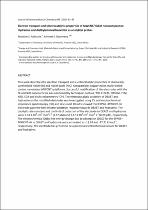 ResearchSpace
ResearchSpace
Electron transport and electrocatalytic properties of MWCNT/nickel nanocomposites: hydrazine and diethylaminoethanethiol as analytical probes
JavaScript is disabled for your browser. Some features of this site may not work without it.
- ResearchSpace
- →
- Research Publications/Outputs
- →
- Journal Articles
- →
- View Item
| dc.contributor.author |
Adekunle, AS

|
|
| dc.contributor.author |
Ozoemena, KI

|
|
| dc.date.accessioned | 2012-04-24T08:40:18Z | |
| dc.date.available | 2012-04-24T08:40:18Z | |
| dc.date.issued | 2010-06 | |
| dc.identifier.citation | Adekunle, AS and Ozoemena, KI. 2010. Electron transport and electrocatalytic properties of MWCNT/nickel nanocomposites: hydrazine and diethylaminoethanethiol as analytical probes. Journal of Electroanalytical Chemistry, vol. 654(1), pp 41-49 | en_US |
| dc.identifier.issn | 1572-6657 | |
| dc.identifier.uri | http://www.sciencedirect.com/science/article/pii/S157266571000175X | |
| dc.identifier.uri | http://hdl.handle.net/10204/5816 | |
| dc.description | Copyright: 2010 Elsevier. This is an ABSTRACT ONLY. | en_US |
| dc.description.abstract | This work describes the electron transport and electrocatalytic properties of chemically-synthesized nickel (Ni) and nickel oxide (NiO) nanoparticles supported on multi-walled carbon nanotubes (MWCNT) platforms. Successful modification of the electrodes with the Ni and NiO nanoparticles was confirmed by techniques such as FTIR, FESEM, HRSEM, TEM, XRD, EDX and cyclic voltammetry (CV). The electrocatalytic oxidation of DEAET and hydrazine on the modified electrodes was investigated using CV electrochemical impedance spectroscopy (EIS) and discussed. Results showed that EPPGE-MWCNT-Ni electrode gave the best electro-oxidation response towards DEAET and hydrazine. The catalytic rate constant and the limit of detection of the electrode to DEAET and hydrazine were 5.93 x 10 9 cm 3 mol -1 s -1 (0.87 µM) and 7.67 x 10 9 cm 3 mol -1 s -1 (0.29 µM), respectively. The electrochemical Gibbs free energy change due to adsorption ( G o ) for the EPPGE-MWCNT-Ni in DEAET and hydrazine were estimated as –18.14 and –17.21 kJmol -1 , respectively. The electrode has proven to be a potential electrochemical sensor for DEAET and hydrazine. | en_US |
| dc.language.iso | en | en_US |
| dc.publisher | Elsevier | en_US |
| dc.relation.ispartofseries | Workflow;6135 | |
| dc.subject | Multi-walled carbon nanotube | en_US |
| dc.subject | Nickel | en_US |
| dc.subject | Nickel oxide nanoparticles | en_US |
| dc.subject | Nanoparticles | en_US |
| dc.subject | Cyclic voltammetry | en_US |
| dc.subject | Impedance spectroscopy | en_US |
| dc.subject | Hydrazine | en_US |
| dc.title | Electron transport and electrocatalytic properties of MWCNT/nickel nanocomposites: hydrazine and diethylaminoethanethiol as analytical probes | en_US |
| dc.type | Article | en_US |
| dc.identifier.apacitation | Adekunle, A., & Ozoemena, K. (2010). Electron transport and electrocatalytic properties of MWCNT/nickel nanocomposites: hydrazine and diethylaminoethanethiol as analytical probes. http://hdl.handle.net/10204/5816 | en_ZA |
| dc.identifier.chicagocitation | Adekunle, AS, and KI Ozoemena "Electron transport and electrocatalytic properties of MWCNT/nickel nanocomposites: hydrazine and diethylaminoethanethiol as analytical probes." (2010) http://hdl.handle.net/10204/5816 | en_ZA |
| dc.identifier.vancouvercitation | Adekunle A, Ozoemena K. Electron transport and electrocatalytic properties of MWCNT/nickel nanocomposites: hydrazine and diethylaminoethanethiol as analytical probes. 2010; http://hdl.handle.net/10204/5816. | en_ZA |
| dc.identifier.ris | TY - Article AU - Adekunle, AS AU - Ozoemena, KI AB - This work describes the electron transport and electrocatalytic properties of chemically-synthesized nickel (Ni) and nickel oxide (NiO) nanoparticles supported on multi-walled carbon nanotubes (MWCNT) platforms. Successful modification of the electrodes with the Ni and NiO nanoparticles was confirmed by techniques such as FTIR, FESEM, HRSEM, TEM, XRD, EDX and cyclic voltammetry (CV). The electrocatalytic oxidation of DEAET and hydrazine on the modified electrodes was investigated using CV electrochemical impedance spectroscopy (EIS) and discussed. Results showed that EPPGE-MWCNT-Ni electrode gave the best electro-oxidation response towards DEAET and hydrazine. The catalytic rate constant and the limit of detection of the electrode to DEAET and hydrazine were 5.93 x 10 9 cm 3 mol -1 s -1 (0.87 µM) and 7.67 x 10 9 cm 3 mol -1 s -1 (0.29 µM), respectively. The electrochemical Gibbs free energy change due to adsorption ( G o ) for the EPPGE-MWCNT-Ni in DEAET and hydrazine were estimated as –18.14 and –17.21 kJmol -1 , respectively. The electrode has proven to be a potential electrochemical sensor for DEAET and hydrazine. DA - 2010-06 DB - ResearchSpace DP - CSIR KW - Multi-walled carbon nanotube KW - Nickel KW - Nickel oxide nanoparticles KW - Nanoparticles KW - Cyclic voltammetry KW - Impedance spectroscopy KW - Hydrazine LK - https://researchspace.csir.co.za PY - 2010 SM - 1572-6657 T1 - Electron transport and electrocatalytic properties of MWCNT/nickel nanocomposites: hydrazine and diethylaminoethanethiol as analytical probes TI - Electron transport and electrocatalytic properties of MWCNT/nickel nanocomposites: hydrazine and diethylaminoethanethiol as analytical probes UR - http://hdl.handle.net/10204/5816 ER - | en_ZA |





